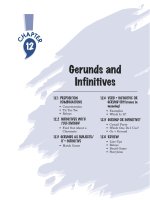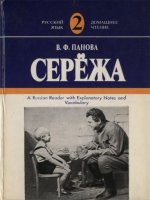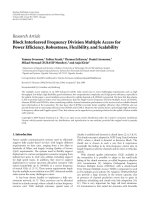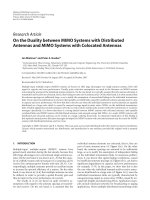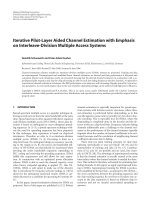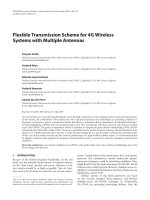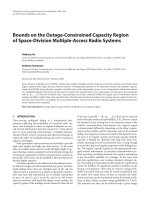Interleaved frequency division multiple access with multiple antennas and block spreading for mobile broadband communications
Bạn đang xem bản rút gọn của tài liệu. Xem và tải ngay bản đầy đủ của tài liệu tại đây (710.26 KB, 146 trang )
INTERLEAVED FREQUENCY DIVISION
MULTIPLE ACCESS WITH MULTIPLE
ANTENNAS AND BLOCK SPREADING FOR
MOBILE BROADBAND
COMMUNICATIONS
PNG KHIAM BOON
B.Eng. (1st Class Hons.), M. Eng., NUS
A THESIS SUBMITTED
FOR THE DEGREE OF DOCTOR OF PHILOSOPHY
DEPARTMENT OF
ELECTRICAL AND COMPUTER ENGINEERING
NATIONAL UNIVERSITY OF SINGAPORE
2013
DECLARATION
I hereby declare that this thesis is my original work and it has been written by
me in its entirety. I have duly acknowledged all the sources of information
which have been used in the thesis.
This thesis has also not been submitted for any degree in any university
previously.
Png Khiam Boon
2 Jan 2013
Acknowledgements
I would like to express my deepest gratitude to my supervisor, Professor Ko Chi
Chung, for his guidance and advice throughout the course of study. As a part-
time student with a full-time job, I am especially grateful for his understanding
when at times my progress was not as quick as one hopes. His timely support
and constant encouragement are also deeply appreciated.
I would like to express my sincere thank to my co-supervisor, Dr Francois
Chin, for his valuable guidance on my research work and his support and en-
couragement.
I also would like to thank Dr Peng Xiaoming for his guidance on my research
work and his kind considerations when I have to take time off work for my study.
Next, I would like to thank the Agency for Science, Technology and Re-
search (A*STAR) and the Institute for Infocomm Research (I
2
R) for the study
award offered to me and the organizations’ support for my part-time study.
Last but not least, I wish to thank my parents for their support and encour-
agement throughout my study. I also wish to thank my wife for her support and
understanding during this hectic period of my life.
i
Contents
Acknowledgements i
Abstract vi
List of Tables viii
List of Figures ix
List of Abbreviations xi
1 Introduction 1
1.1 Evolution of Air Interface of Mobile Cellular Systems . . . . . . 1
1.2 Interleaved Frequency Division Multiple Access . . . . . . . . . 4
1.3 Motivations and Scope . . . . . . . . . . . . . . . . . . . . . . 5
1.4 Contributions in Thesis . . . . . . . . . . . . . . . . . . . . . . 6
1.5 Thesis Organization . . . . . . . . . . . . . . . . . . . . . . . . 8
2 Generalized Iterative Soft QRD-M Algorithm for IFDMA System 10
2.1 Introduction . . . . . . . . . . . . . . . . . . . . . . . . . . . . 10
2.2 System Signal Model . . . . . . . . . . . . . . . . . . . . . . . 13
2.2.1 IFDMA Signal Model . . . . . . . . . . . . . . . . . . 13
2.2.2 General Signal Model for MIMO-IFDMA . . . . . . . . 20
2.3 Theoretical Performance Analysis . . . . . . . . . . . . . . . . 23
2.3.1 Large number of assigned sub-carriers per user, S ≥ P . 24
2.3.2 Small number of assigned sub-carriers per user, S < P . 29
ii
2.3.3 MIMO-IFDMA . . . . . . . . . . . . . . . . . . . . . . 31
2.4 Maximizing Channel Diversity Order . . . . . . . . . . . . . . 32
2.4.1 FH-IFDMA System . . . . . . . . . . . . . . . . . . . 32
2.4.2 BS-IFDMA System . . . . . . . . . . . . . . . . . . . . 33
2.4.3 Comparison Between FH-IFDMA and BS-IFDMA . . . 33
2.5 Iterative Soft QRD-M Algorithm . . . . . . . . . . . . . . . . . 34
2.5.1 QR Decomposition . . . . . . . . . . . . . . . . . . . . 35
2.5.2 Soft QRD-M Algorithm . . . . . . . . . . . . . . . . . 37
2.5.3 SISO ECC Decoder . . . . . . . . . . . . . . . . . . . . 42
2.5.4 Computational Complexity . . . . . . . . . . . . . . . . 42
2.5.5 Generalized Algorithm for MIMO-IFDMA . . . . . . . 43
2.6 Simulation Results . . . . . . . . . . . . . . . . . . . . . . . . 44
2.6.1 Simulation System . . . . . . . . . . . . . . . . . . . . 45
2.6.2 ZF versus MMSE QR Decomposition . . . . . . . . . . 47
2.6.3 Effects of Varying Number of Paths to Keep in Each Stage 48
2.6.4 Varying Number of Channel Paths . . . . . . . . . . . . 48
2.6.5 Multiple Receive Antennas System . . . . . . . . . . . 50
2.6.6 Spatial Multiplexing System with Multiple Transmit and
Receive Antennas . . . . . . . . . . . . . . . . . . . . . 51
2.6.7 Maximizing Diversity Performance with Frequency Hop-
ping and Block Spreading . . . . . . . . . . . . . . . . 53
2.7 Chapter Summary . . . . . . . . . . . . . . . . . . . . . . . . . 55
3 Transmit Diversity Technique for IFDMA System 56
3.1 Introduction . . . . . . . . . . . . . . . . . . . . . . . . . . . . 56
3.2 System Signal Model . . . . . . . . . . . . . . . . . . . . . . . 59
3.2.1 Cyclic Delay Diversity . . . . . . . . . . . . . . . . . . 59
3.2.2 Antenna Spreading Diversity . . . . . . . . . . . . . . . 61
3.2.3 Combining Cyclic Delay Diversity and Antenna Spread-
ing Diversity . . . . . . . . . . . . . . . . . . . . . . . 63
iii
3.3 Theoretical Performance Analysis . . . . . . . . . . . . . . . . 66
3.4 Simulation Results . . . . . . . . . . . . . . . . . . . . . . . . 69
3.4.1 Simulation System . . . . . . . . . . . . . . . . . . . . 69
3.4.2 Comparison Between ASD and CDD . . . . . . . . . . 71
3.4.3 Combining ASD and CDD . . . . . . . . . . . . . . . . 72
3.5 Chapter Summary . . . . . . . . . . . . . . . . . . . . . . . . . 74
4 Mobility-Based Interference Cancellation Scheme For BS-IFDMA
System with Optimum Code Assignment 75
4.1 Introduction . . . . . . . . . . . . . . . . . . . . . . . . . . . . 75
4.2 System Signal Model . . . . . . . . . . . . . . . . . . . . . . . 77
4.3 Mobility-Based Successive Interference Cancellation . . . . . . 81
4.3.1 Multiple Access Interference in BS-IFDMA System . . 81
4.3.2 Successive Interference Cancellation . . . . . . . . . . . 83
4.3.3 Multiple Access Interference in Different SIC Stages . . 86
4.3.4 Comparison with Conventional Power based SIC . . . . 86
4.4 Optimal Code Assignment . . . . . . . . . . . . . . . . . . . . 87
4.4.1 Bounding Procedure . . . . . . . . . . . . . . . . . . . 90
4.4.2 Branch-and-Bound Strategy . . . . . . . . . . . . . . . 93
4.4.3 Equivalent Solutions . . . . . . . . . . . . . . . . . . . 97
4.4.4 Fast Code Assignment Algorithm . . . . . . . . . . . . 99
4.5 Theoretical Performance Analysis . . . . . . . . . . . . . . . . 101
4.6 Simulation Results . . . . . . . . . . . . . . . . . . . . . . . . 108
4.6.1 Simulation System . . . . . . . . . . . . . . . . . . . . 108
4.6.2 Channel Dependent Code Assignment . . . . . . . . . . 109
4.6.3 System BER with High Mobility Users . . . . . . . . . 110
4.6.4 Operational System BER . . . . . . . . . . . . . . . . . 113
4.7 Chapter Summary . . . . . . . . . . . . . . . . . . . . . . . . . 115
iv
5 Summary 117
5.1 Summary of Thesis Contributions . . . . . . . . . . . . . . . . 118
5.2 Future Works . . . . . . . . . . . . . . . . . . . . . . . . . . . 120
Bibliography 122
v
Abstract
In this thesis, we study and propose enhancements to improve the performance
of interleaved frequency division multiple access (IFDMA) in the uplink trans-
mission of mobile broadband system. Our theoretical performance analysis
of coded IFDMA system shows that receivers using maximum likelihood se-
quence estimation (MLSE) can maximize the available channel diversity if the
required system design criteria are met. We formulate a generalized signal
model for coded IFDMA system with different numerical configurations of
transmit and receive antennas and proposed an iterative soft QRD-M algorithm
for joint detection and decoding scheme of coded IFDMA systems based on the
model. The proposed algorithm achieves similar diversity order as MLSE at
a much lower complexity cost and its performance approaches the theoretical
ideal lower bound within a few iterations. We also introduce a novel trans-
mit diversity for IFDMA system. This antenna spreading diversity (ASD) can
be used with a single receive antenna and be easily scaled up to work in sys-
tems with different number of numbers of transmit antennas. Moreover, we use
block spreading (BS) with IFDMA to suppress inter-cell interference (ICI) while
maintaining intra-cell orthogonality for low mobility users. The use of block
spreading also allows more sub-carriers to be assigned to each user, thereby in-
creasing the available frequency diversity for each user. To counter the loss of
code orthogonality due to the presence of high mobility user in the system, we
propose a novel scheme where the allocation of the users’ operating sub-carriers
and spreading codes is dependent on their mobility and a mobility-based mul-
tiple access interference (MAI) cancellation scheme is used at the receiver to
vi
maintain system performance.
vii
List of Tables
2.1 IFDMA Simulation System. . . . . . . . . . . . . . . . . . . . . . . 45
2.2 Simulation System Configurations for Section 2.6.2 - Section 2.6.4. . . . . 46
2.3 Simulation System Configurations for FH-IFDMA and BS-IFDMA System. . 53
3.1 Simulation System Configuration for Transmit Diversity. . . . . . . . . . 71
4.1 Mean Number of Branches Visited. . . . . . . . . . . . . . . . . . . . 100
viii
List of Figures
2.1 Frequency and Time Domain User-Separation . . . . . . . . . . 16
2.2 Equivalent Single-User System Model for coded IFDMA System 18
2.3 Equivalent Single-User System Model for coded MIMO-IFDMA 22
2.4 Theoretical Upper Bound for Exponential Decay vs Uniform
Power Delay Profile for S = 32. . . . . . . . . . . . . . . . . . 29
2.5 Theoretical Upper Bound for Exponential Decay vs Uniform
Power Delay Profile for P = 32. . . . . . . . . . . . . . . . . . 30
2.6 Iterative Soft QRD-M Algorithm for Detection and Decoding of
coded IFDMA System. . . . . . . . . . . . . . . . . . . . . . . 36
2.7 Decoding Tree for S = 3, Q = 2. . . . . . . . . . . . . . . . . . 39
2.8 BER Performance Comparison for ZF QRD and MMSE QRD. . 46
2.9 BER Performance Comparison for Varying M. . . . . . . . . . 47
2.10 BER Performance for P = 8. . . . . . . . . . . . . . . . . . . . 49
2.11 BER Performance for P = 16. . . . . . . . . . . . . . . . . . . 49
2.12 BER Performance for P = 32. . . . . . . . . . . . . . . . . . . 50
2.13 BER Performance Comparison for A
T
= 1, A
R
= 2, P = 16. . . 51
2.14 BER Performance Comparison for A
T
= 2, A
R
= 2, P = 8. . . 52
2.15 BER Performance with Total Diversity Order = 32. . . . . . . . 52
2.16 Performance Comparison between IFDMA, FH-IFDMA, BS-
IFDMA Systems. . . . . . . . . . . . . . . . . . . . . . . . . . 54
2.17 FDE Performance Comparison between IFDMA, FH-IFDMA,
BS-IFDMA Systems. . . . . . . . . . . . . . . . . . . . . . . . 54
ix
3.1 Theoretical BER Performance Comparison for proposed ASD
and CDD. . . . . . . . . . . . . . . . . . . . . . . . . . . . . . 69
3.2 Theoretical BER Performance Comparison for Combined Di-
versity Scheme. . . . . . . . . . . . . . . . . . . . . . . . . . . 70
3.3 BER Performance Comparison for proposed ASD and CDD. . . 72
3.4 BER Performance Comparison for proposed ASD and CDD
with Combined Diversity Scheme. . . . . . . . . . . . . . . . . 73
4.1 Mean pairwise MAI power for S = 32, B = 8 . . . . . . . . . . . 83
4.2 Distribution of Mean Interference Power using Random Code
Assignment . . . . . . . . . . . . . . . . . . . . . . . . . . . . 84
4.3 Successive MAI Cancellation for BS-IFDMA System for B = 4. 85
4.4 Flowchart of Branch-and-Bound Algorithm. . . . . . . . . . . . 94
4.5 Changes to Cost Matrix due to Partial Assignment . . . . . . . . 96
4.6 Histogram of Number of Users with Different Code Assigned
by The Two Algorithms. . . . . . . . . . . . . . . . . . . . . . 101
4.7 Theoretical BER Error Floor. . . . . . . . . . . . . . . . . . . . 108
4.8 Cumulative Frequency of the Ratio (MAI using Code Assign-
ment V
M
: MAI using Code Assignment V
A
). . . . . . . . . . 109
4.9 BER Comparisons between Different Systems. . . . . . . . . . 111
4.10 BER Comparisons between Different Spreading Codes. . . . . . 112
4.11 BER Performance of Coded BS-IFDMA System . . . . . . . . 114
x
List Of Abbreviations
APP A Posterior Probability
ASD Antenna Spreading Diversity
ASIC Application Specific Integrated Circuit
AWGN Additive White Gaussian Noise
BER Bit Error Rate
BS Block Spreading
CDD Cyclic Delay Diversity
CDMA Code Division Multiple Access
DFT Discrete Fourier Transform
FDE Frequency Domain Equalizer
FDMA Frequency Division Multiple Access
FEC Forward Error Correcting
FFT Fast Fourier Transform
FH Frequency Hopping
FSTD Frequency Switched Transmit Diversity
GMSK Gaussian Minimum Shift Keying
GSM Global System for Mobile Communications
ICI Inter-Cell Interference
IFDMA Interleaved Frequency Division Multiple Access
LAP Linear Assignment Problem
LLR Log Likelihood Ratio
LMMSE Linear Minimum Mean Squared Error
xi
MAI Multiple Access Interference
MAP Maximum A Posteriori
MFLB Matched Filter Lower Bound
MIMO Multiple-Inputs Multiple-Outputs
ML Maximum Likelihood
MLSE Maximum Likelihood Sequence Estimation
OCI Out-of-Cell Interference
OFDM Orthogonal Frequency Division Multiplexing
OFDMA Orthogonal Frequency Division Multiple Access
PAPR Peak-to-Average Power Ratio
PDF Probability Density Function
QAM Quadrature Amplitude Modulation
QAP Quadratic Assignment Problem
QPSK Quadrature Phase Shift Keying
QRD Orthogonal Matrix Triangularization (QR) Decomposition
QS Quasi-Synchronous
SC-FDMA Single Carrier - Frequency Division Multiple Access
SFBC Space Frequency Block Code
SIC Successive Interference Cancellation
SINR Signal-to-Interference and Noise Ratio
SISO Soft-In Soft-Out
STBC Space Time Block Code
TDMA Time Division Multiple Access
VLSI Very Large Scale Integration
ZF Zero Forcing
xii
Chapter 1
Introduction
Mobile cellular communications has become the pervasive technology for the
21st century. With the advent of social media, mobile gaming and video stream-
ing services as well as the prevalent of the mobile computing devices such as
smartphones and tablets, consumers are increasingly demanding higher data
speed and greater coverage area. Along with more spectrum allocations, the
evolution of the air interface, which forms the backbone of mobile wireless
communications, is paramount to meet the growing demand. Correspondingly,
new signal processing algorithms which can maximize the benefits of the new
air interface need to be developed and implemented. We focus on the develop-
ment of algorithms which leverage on the benefits of the emerging air interface
considered for the uplink in future mobile cellular systems. Before introduc-
ing our proposed algorithms, we will provide a brief history of the evolution
of the air interface in mobile cellular system in this chapter. In addition, our
motivations and contributions in this thesis are also presented in this chapter.
1.1 Evolution of Air Interface of Mobile Cellular
Systems
The first public mobile telephone system began operation in the United States
of America (USA) in 1946 [1]. Mobile phones were assigned a single perma-
nent channel for two-way communications via push-to-talk concepts [2]. Im-
1
provement was made to the system to support full-duplexing in the 1960s but
the system remained impractical because of capacity constraints. For example,
only twelve simultaneous calls could be supported over a 1,000 square miles
area in New York City which had a market of ten million people in 1976 [1].
The cellular concept featuring frequency reuse, which helps to solve the capac-
ity constraints, was demonstrated in 1968 at Bell Laboratories. Together with
the invention of microprocessor, it paved the way for the deployment of the first
commercial 1G cellular system, the Mobile Communication System L1, by the
Nippon Telegraph and Telephone (NTT) [2]. This was followed by the deploy-
ment of European 1G systems in Scandinavia in 1981, in United Kingdom in
1982 and in France and Germany in 1985. The first commercial 1G cellular
system arrived in the USA in 1983 [1].
The 1G cellular systems were all analog systems relying on frequency or am-
plitude modulation, which suffered from bandwidth inefficiency [2], for trans-
mission. In the late 1980s, the maturity of very large scale integration (VLSI)
and signal processing technology led to the digital revolution. The new digital
2G cellular system rode on the wave of the digital technology with the digital
signal processors in application specific integrated circuits (ASICs) helping to
miniaturize mobile phone sizes. The digital 2G systems also allowed, for the
first time, the use of block and/or convolutional coding for error correction re-
sulting in clearer voice transmissions and more reliable data transmission over
fading channels. The 2G systems also introduced the use of digital modula-
tions such as Gaussian minimum shift keying (GMSK) and quaternary phase
shift keying (QPSK). Sophisticated multiple access technology like frequency
division multiple access (FDMA), time division multiple access (TDMA) and
code division multiple access (CDMA) also gained prominent usage in the dig-
ital 2G systems. Popular 2G systems include the TDMA/FDMA based Global
System for Mobile Communications (GSM), which was first adopted by the Eu-
ropean countries in 1991, and the CDMA based IS-95A standards, which gained
2
widespread deployment by 1996 [1]. At the beginning of this century, the 2G
mobile cellular systems introduced packet switching [3] to allow for easier data
transmission which became, and continues to be, a main feature in mobile cel-
lular systems.
The next driver for upgrades in cellular system was the requirement for
multimedia-level data rates and the push for greater data rates soon resulted in
the deployment of the 3G cellular systems. In the 3G era, CDMA rose in promi-
nence as it became the multiple access technology of choice for the two most
popular 3G system standards: Wideband CDMA (W-CDMA) and CDMA2000.
Compared to FDMA/TDMA, CDMA is more robust against multipath fading,
provides greater coverage with fewer cell sites and enables better frequency
reuse [4, 5]. 3G systems are also characterized by the usage of powerful turbo
codes [6,7] to improve performance and the usage of higher order of quadrature
amplitude modulation (QAM) constellations such as the 16QAM and 64 QAM
to support higher data rates. However, the use of these higher order modulations
is usually restricted to short range transmission [2].
The 3rd Generation Partnership Project(3GPP) consortium officially com-
menced the standardization work on mobile cellular systems beyond 3G under
the name of 3G Long Term Evolution (LTE) in 2006. In a departure from ex-
isting 3G systems, multiple access technologies based on orthogonal frequency
division multiplexing (OFDM) air interface were chosen [8]. In the downlink,
the popular orthogonal frequency division multiple access (OFDMA) is chosen
while single carrier frequency division multiple access (SC-FDMA), which uses
similar wireless air interface as OFDMA, is the chosen uplink multiple access
technology [8]. Multiple antennas technology, which is regarded as the key
technology to provide high capacity and data rates [2], was also incorporated in
the 3G LTE systems.
3
1.2 Interleaved Frequency Division Multiple Ac-
cess
SC-FDMA is the chosen uplink multiple access technology for 3G LTE and
LTE-Advanced cellular system [8]. SC-FDMA uses similar wireless air inter-
face as the popular OFDMA technology used in the downlink of the cellular
systems. However, unlike OFDMA, SC-FDMA shifts the bulk of the processing
complexity to the receiver at the base-station and has a lower peak-to-average
power ratio (PAPR) which makes it a more attractive candidate for uplink trans-
mission [9]. SC-FDMA facilitates the multiple access in the uplink through
apportioning different sub-carriers to different users like in OFDMA. There are
two approaches to the division of the sub-carriers to the users. The first is local-
ized SC-FDMA (LFDMA) that assigns each mobile device a set of adjacent sub-
carriers for its transmission. The second is distributed SC-FDMA, which is com-
monly realized as interleaved FDMA (IFDMA), that assigns a set of equidis-
tantly distributed sub-carriers to each user [9]. Recently, a new sub-carrier as-
signment scheme known as block IFDMA (B-IFDMA) has emerged that assigns
interleaved blocks of continuous sub-carriers to a single user [10, 11].
The use of frequency division multiple access preserves the users orthogo-
nality in frequency-selective channels but exposes SC-FDMA to the problem of
inter-cell interference (ICI) in the absence of cellular frequency reuse [12] [13]
[14]. Solutions such as fractional frequency reuse reduce the spectrum avail-
ability at the cell edge [13], while solutions such as adaptive frequency reuse
scheduling [12] [14] requires channel information which may not be readily
available in the case of fast moving mobile devices. Moreover, the through-
put performance of the SC-FDMA system, especially those using LFDMA, is
also dependent on resource scheduling using accurate real-time channel infor-
mation [9, 15].
4
1.3 Motivations and Scope
Previous performance analysis on IFDMA systems focused on the frequency
domain [16, 17] with the assumption that the different sub-carriers assigned to
a user experienced independent fading. Hence, it is difficult to establish quan-
titatively, the maximum channel diversity order achievable by IFDMA systems.
Moreover, [16] only establishes an imprecise relationship between the number
of sub-carriers assigned to a user and the diversity obtained by that user. We
know from [15] that the frequency diversity gain, and hence the performance,
in IFDMA systems is affected by the number of the sub-carriers assigned to a
user relative to the total number of sub-carriers available in the system. The
amount of frequency diversity gain determines the necessity and the usefulness
of multi-user scheduling [15]. We seek to analyze the performance of IFDMA
system in dense multipath environments [18] and establish the quantitative rela-
tionship between the number of sub-carriers assigned per user and the diversity
order a user can achieve. Also, we like to determine the criteria required for
coded IFDMA systems to achieve the maximum channel diversity order.
The simple frequency domain equalizer (FDE), though straightforward to
design and implement, limit the diversity performance in the the receiver [19].
Maximum likelihood sequence estimation (MLSE) guarantees the diversity per-
formance but is too complicated to be implemented, especially for the higher
order of modulations and advanced error correcting code considered in future
cellular system. We propose the use of an implementable iterative detection
and decoding algorithm at the receiver to achieve the theoretical diversity per-
formance of the MLSE. We also generalize the algorithm to use in IFDMA
systems with multiple antennas employing either spatial multiplexing or trans-
mit diversity schemes. The insights we gained from our theoretical analysis of
IFDMA system also lead us to propose a novel transmit diversity scheme for
coded IFDMA system. We compare the new scheme to existing schemes and
demonstrate the effectiveness of the proposed scheme.
5
Next, we tackle the problem of FDMA systems’ inability to reject ICI with-
out the use of frequency reuse. We investigate the concept of two-layered
spreading to reject out-of-cell interference (OCI) used in variable spreading
factor(VSF)-orthogonal frequency/code division multiplexing (VSF-OFCDM)
system [20, 21], which is a candidate for the 4G cellular system [2]. We ex-
tend the two-layered spreading concept to IFDMA and propose a block spread
(BS)-IFDMA system. The performance of BS-IFDMA systems in time variant
channels is analyzed and is found to be susceptible to the interferences caused
by the presence of high mobility users. As support for high mobility users is cru-
cial in future mobile system to cater for the ”always-connected” experience, we
propose a novel mobility-based MAI cancellation scheme to incorporate high
mobility users into a BS-IFDMA system without degrading the system perfor-
mance.
1.4 Contributions in Thesis
We have carried out a theoretical performance analysis of IFDMA systems and
propose a number of algorithms to minimize the bit error rate (BER) perfor-
mance of IFDMA systems. Specifically, we have proposed a generalized it-
erative detection and decoding algorithm based on QR decomposition and M-
algorithm (QRD-M algorithm) for coded MIMO-IFDMA systems, which have
similar diversity performance as MLSE. We also propose a new transmit an-
tenna diversity scheme for coded IFDMA systems which can be decoded at
the receiver using the proposed iterative soft QRD-M algorithm. The proposed
transmit antenna diversity scheme can be used on its own or be combined with
the cyclic delay diversity scheme to maximize the diversity performance of
coded MIMO-IFDMA systems. In addition, we apply the concept of two-
layered spreading to IFDMA systems and propose a mobility-based multiple
access interference cancellation scheme to incorporate high mobility users in
6
the resulting BS-IFDMA systems.
We introduce a new generalized signal model for coded IFDMA systems
with different numerical configurations of transmit and receive antennas. We
analyze the theoretical upper bound of coded IFDMA system based on the
new signal model and specify the design criteria for coded IFDMA systems
to achieve the maximum channel diversity order regardless of the number of
sub-carriers assigned per user. Moreover, we present a recursive calculation of
log-likelihood ratio that enables the use of M-algorithm in a soft QRD-M APP
detector to achieve the maximum diversity order at low complexity. We also pro-
pose a generalized iterative soft QRD-M algorithm for detection and decoding
for coded MIMO-IFDMA system. The performance of the proposed algorithm
approaches the ideal matched filter lower bound at high SNR and achieves a
performance gain of up to 6 dB over linear MMSE detector.
The generalized signal model is used to design a novel transmit diversity
named antenna spreading diversity scheme that has a guaranteed diversity gain
factor equal to the number of transmit antennas used, if the receiver uses MLSE.
We demonstrate through simulation that the proposed iterative soft QRD-M al-
gorithm is able to match the diversity performance of MLSE for the proposed
antenna spreading diversity scheme. We also analyze and compare the theoreti-
cal performance between the proposed antenna diversity scheme and the popu-
lar cyclic delay diversity scheme to show the benefits of the proposed scheme as
well as to illustrate how the two schemes are complementary to each other. We
specify the design criterion for the configuration of a combined transmit diver-
sity scheme to suit the requirements of different systems and show the benefits
of the combined diversity scheme through theoretical performance analysis and
simulations.
We derive the multiple access interference (MAI) in BS-IFDMA system
under time-varying channel and introduce a novel MAI cancellation scheme
based on the users’ mobilities. We formulate the total MAI in a system with
7
the proposed interference cancellation scheme to result in a quadratic assign-
ment problem (QAP) to optimize the spreading code assignments for the users.
Based on the characteristics of common spreading codes such as the Walsh-
Hadamard and Orthogonal Gold codes, we devise a simplified search procedure
in a branch-and-bound algorithm for solving the QAP. The simplified search
procedure lowers the time taken to arrive at the solution by a factor which is
equal to five times the spreading factor. We analyze the bit error rate (BER)
performance of the proposed MAI cancellation scheme and show that with the
cancellation scheme, the BER error floor due to the MAI caused by a high mo-
bility user will always be lower than the theoretical BER. Conversely, without
the cancellation scheme, the theoretical BER will always hit the error floor,
limiting the system performance. We also show, through simulation, that the
proposed MAI cancellation scheme coupled with the proposed optimized codes
assignment enables up to half the total number of users in BS-IFDMA systems
to be high mobility users while maintaining the system performance.
1.5 Thesis Organization
The thesis consists of five chapters. In this chapter, the evolution of the mobile
cellular communications is briefly introduced to provide a general context to
the investigations done on IFDMA system in the thesis. The motivations and
contributions were also presented in this chapter. In Chapter 2, we introduce
the generalized signal model for coded MIMO-IFDMA systems and present
the proposed iterative soft QRD-M algorithm. We derive the theoretical BER
performance of coded MIMO-IFDMA systems and formulate the criteria for
maximizing the channel diversity in coded MIMO-IFDMA systems. In Chap-
ter 3, we analyze the theoretical performance of the proposed transmit diversity
scheme and demonstrate the ability of the proposed iterative soft QRD-M algo-
rithm to match the theoretical performance through simulation. In Chapter 4,
8
we consider the use of block spreading in IFDMA systems and propose a novel
multiple access interference cancellation scheme designed to incorporate high
mobility users in BS-IFDMA systems. Lastly, Chapter 5 summarizes the re-
search work in this thesis and provide suggestions for future work.
9
Chapter 2
Generalized Iterative Soft QRD-M
Algorithm for IFDMA System
2.1 Introduction
Interleaved frequency division multiple access (IFDMA) scheme introduced
in [22] is a promising candidate for the uplink transmission in next generation
mobile wireless access system [16,23–25]. IFDMA has also been formulated as
either an orthogonal frequency division multiple access (OFDMA) scheme [26]
with discrete fourier transform (DFT) precoding and equidistant frequency map-
ping [17, 24, 25, 27] or a code division multiple access (CDMA) scheme with
specialized spreading codes [28, 29](i.e. frequency-domain orthogonal spread-
ing codes, comb-spectrum codes). IFDMA is able to maintain perfect user
orthogonality in frequency-selective channel [16, 29] like OFDMA. However,
unlike OFDMA, IFDMA is a single-carrier (SC) scheme that guarantees low
peak-to-average power ratio (PAPR) in the transmitted signals making it more
suitable than OFDMA in uplink transmission [17, 24].
In this chapter, we introduce a new signal model in time domain using con-
ventional MIMO matrix formulation for IFDMA systems, which provides a bet-
ter insight of the inherent diversity attainable in the system. Instead of using the
frequency domain signal model of IFDMA favored in [17,24], we formulate the
signal model of a IFDMA system in the time domain similar to [22]. In addition,
we show that the IFDMA time domain signal model represented in matrix nota-
10
tions has the same form as a multiple-inputs multiple-outputs (MIMO) system.
Using this model, the performance analysis on the bit error rate (BER) perfor-
mance of coded IFDMA systems in a frequency-selective multipaths environ-
ment can be carried out. We also extend the signal model to form a generalized
system signal model to describe coded IFDMA systems with different numerical
configurations of transmit and receive antennas employing spatial multiplexing.
Previous performance analysis on IFDMA systems focused on the frequency
domain [16, 17] with the assumption that the different sub-carriers assigned to
a user experienced independent fading. Hence, it is difficult to establish quan-
titatively, the maximum channel diversity order achievable by IFDMA systems.
Moreover, [16] only establishes an imprecise relationship between the number
of sub-carriers assigned to a user and the diversity obtained by that user. Using
our system model, we derive the upper bound on the BER of coded IFDMA sys-
tem based on maximum likelihood sequence estimation (MLSE) in a frequency-
selective channel. The BER performance analysis gives us quantitative insights
on the relationship between the diversity order a user can achieve and the num-
ber of sub-carriers assigned to the user, as well as the criteria required for coded
IFDMA systems to achieve the maximum channel diversity order.
Following the insights gained from the analysis, we design frequency hop-
ping sequences that will enable all users within the system to achieve the max-
imum channel diversity order regardless of the number of sub-carriers assigned
to each user. Alternatively, we can apply block spread technique [30] using
the appropriate spreading factor to achieve the same diversity order. We shall
compare the two techniques, discussing their respective advantages and disad-
vantages in terms of operational complexity as well as BER performance.
Various receiver structures have been proposed for uncoded IFDMA sys-
tem, ranging from the simple frequency domain equalizer (FDE) [27] to the
complex iterative block decision feedback equalizer (IB-DFE) [24,31]. IB-DFE
has significantly better performance than the simple feed forward FDE [24] and
11
